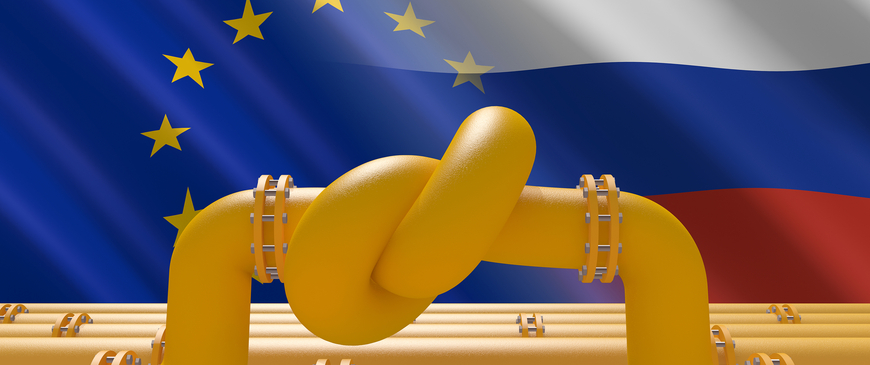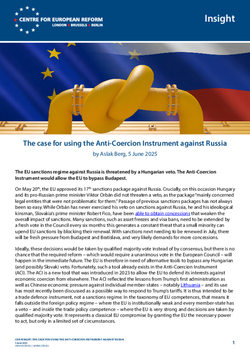
The case for using the Anti-Coercion Instrument against Russia
The EU sanctions regime against Russia is threatened by a Hungarian veto. The Anti-Coercion Instrument would allow the EU to bypass Budapest.
On May 20th, the EU approved its 17th sanctions package against Russia. Crucially, on this occasion Hungary and its pro-Russian prime minister Viktor Orbán did not threaten a veto, as the package “mainly concerned legal entities that were not problematic for them.” Passage of previous sanctions packages has not always been so easy. While Orbán has never exercised his veto on sanctions against Russia, he and his ideological kinsman, Slovakia’s prime minister Robert Fico, have been able to obtain concessions that weaken the overall impact of sanctions. Many sanctions, such as asset freezes and visa bans, need to be extended by a fresh vote in the Council every six months: this generates a constant threat that a small minority can upend EU sanctions by blocking their renewal. With sanctions next needing to be renewed in July, there will be fresh pressure from Budapest and Bratislava, and very likely demands for more concessions.
Ideally, these decisions would be taken by qualified majority vote instead of by consensus, but there is no chance that the required reform – which would require a unanimous vote in the European Council – will happen in the immediate future. The EU is therefore in need of alternative tools to bypass any Hungarian (and possibly Slovak) veto. Fortunately, such a tool already exists in the Anti-Coercion Instrument (ACI). The ACI is a new tool that was introduced in 2023 to allow the EU to defend its interests against economic coercion from elsewhere. The ACI reflected the lessons from Trump’s first administration as well as Chinese economic pressure against individual member-states – notably Lithuania – and its use has most recently been discussed as a possible way to respond to Trump’s tariffs. It is thus intended to be a trade defence instrument, not a sanctions regime. In the taxonomy of EU competences, that means it falls outside the foreign policy regime – where the EU is institutionally weak and every member-state has a veto – and inside the trade policy competence – where the EU is very strong and decisions are taken by qualified majority vote. It represents a classical EU compromise by granting the EU the necessary power to act, but only in a limited set of circumstances.
In the Anti-Coercion instrument the EU has a ready-made tool to bypass any Hungarian veto against Russia sanctions.
In order to activate the ACI the European Council first must declare, by qualified majority vote, that the EU is subject to economic coercion by a third country. The third country will then normally get the chance to remedy the situation, although this process can be cut short if the situation demands it. Once the existence of economic coercion has been established, the Commission can propose countermeasures that would require a qualified majority vote by the Council to block, giving the Commission ample room to act. What is unique about the ACI compared with other trade defence measures is that it allows for an extraordinarily wide set of possible measures. It is not just limited to tariffs, but extends to services, simple prohibition of trade and even suspension of normal international obligations such as protection of intellectual property rights and access to insurance, finance or foreign investment. Moreover, the list of measures enumerated in the ACI is not comprehensive – the ACI also contains provisions for expanding the list of possible measures where necessary, though this would require an enabling act to be passed by the European Council and Parliament.
Crucially, these measures can target a country as a whole, or companies and individuals connected to the government. It is, in many ways the equivalent of a full-blown sanctions regime with a fairly complete toolkit for economic warfare, albeit with the proviso that it must be for self-defence. It is not for nothing that the ACI has been referred to as the EU’s trade ‘bazooka’.
Can the ACI be used against Russia? To do so, the EU would have to establish that Russia is exercising economic coercion against the EU. This should be easy to do: we now know, for instance, that Russia already started restricting natural gas exports against the EU in 2021 in preparation for its invasion of Ukraine. The idea, which ultimately failed, was to keep Europe’s gas storage almost empty, making Europe as vulnerable as possible to the threat of Russia turning off the flow of natural gas in the midst of winter. After the invasion in February, this was quickly followed by a demand that European countries pay for gas in roubles, followed by further cuts in natural gas supplies to Poland and Bulgaria in May 2022. As we now know, the natural gas weapon was a dud: Europe stood firm in its sanctions on Russia throughout an exorbitantly expensive energy crisis in 2022, and has been facing persistently higher prices ever since. But the ACI only requires economic coercion to exist, not for it to be effective. There is ample evidence that economic coercion took place.
Russia is guilty of economic coercion against the EU at a cost to EU taxpayers of hundreds of billions of Euros. The EU could claim reparations to put pressure against Russia.
Nor does Russian economic coercion end with natural gas. Since 2022, European aviation has been blocked from crossing Russian air space putting European carriers at significant competitive disadvantage on routes to Asia. Russia also seized more than 400 aircraft worth $10 billion leased to Western, largely European, companies. Nor has Russia respected European foreign investment or intellectual property rights: Russian companies are banned from paying dividends to ‘unfriendly’ countries, foreign companies are banned from selling Russian securities, and loan repayments to foreign investors can only be made in roubles to a Russian bank account. Moreover, export bans are in place for a number of products.
It is true that some of these actions were responses to Western sanctions, including EU actions. And Russia would surely argue that using the ACI amounts to legal chutzpah, punishing Russia for responding to sanctions. But that should be disregarded for two reasons: one, Russia is the aggressor, and the evidence clearly suggests its economic coercion against Europe started in 2021. Second, the EU sanctions regime is a legitimate foreign policy response to Russia’s aggression. The ACI sets out two criteria that third countries must fulfil for the ACI to apply. A third country must a) “interfere in the legitimate sovereign choices of the Union or a member-state by seeking to prevent or obtain the cessation, modification or adoption of a particular act by the Union or a member-state” and it must do so by b) applying or threatening to apply measures affecting trade or investment.
Both EU support for Ukraine and its application of sanctions against Russia are legitimate sovereign choices that Russia has actively interfered with, validating the first criterion. And it is clear that the second criterion is also fulfilled, since Russia has applied measures affecting trade or investment. Therefore, any trade-related Russian response that aims to dissuade the EU from supporting Ukraine and punishing Russia for its violations of international law is ipso facto economic coercion under the terms of the ACI. The EU is under no obligation to grant any kind of legitimacy to Russia’s economic pressure, whether applied at Russia’s own initiative or as a response to the EU’s sanctions.
Russian retaliation against the EU is economic coercion – the EU does not need to grant any kind of legitimacy to Russian economic pressure.
One difference between the ACI and the traditional sanctions regime is that the ACI is strictly motivated by economic coercion, not other aspects of foreign policy. The EU could not, therefore invoke the ACI based on Russia’s invasion of Ukraine, only on the basis of the economic coercion that Russia has inflicted on the EU. And as EU efforts to eliminate its dependence on Russian gas accelerate, there is a paradox in punishing Russia for cutting gas supplies when the EU itself is trying to cut its demand for Russian gas. One could also imagine a scenario where Russia stays in Ukraine, but removes restrictions on trade with the EU, thus ending economic coercion. Another difference from the sanctions regime is that any measures under the ACI would have to be proportional to the economic damage done to the EU. Would this enable Russia to escape the ACI?
The answer is twofold. First, while the ACI is primarily conceived as a tool to end economic coercion, it also contains language that allows the EU to demand reparations for the cost to the EU of Russian economic coercion. And that cost is vast. By February 2023, EU countries had spent almost €700 billion to help EU companies and households face the soaring cost of energy. The high energy costs have caused a contraction in energy-hungry industry, a recession in Germany and permanently higher energy prices in Europe. Even in 2023 the EU’s fossil-fuel import bill was €427 billion, 45 per cent higher than the long-term average. In sum, the EU could easily and plausibly demand reparations in the trillion-euro class. This means on the one hand that proportionality is not a significant barrier and on the other hand that the EU can make Russia an offer they will have to refuse, as the financial cost of reparations would be far beyond Russia’s means – even in the unlikely scenario they were willing to pay. If Russia’s war on Ukraine were to end, the ACI also has the flexibility needed to end measures at will or as part of a negotiated package.
The second part of the answer is that although the ACI is another arrow in the Commission’s quiver, it should ideally complement the sanctions regime, not be a substitute for it. The mere fact of activating the ACI as an alternative legal tool would weaken the impact of any veto threats and strengthen the Commission’s internal negotiating position against pro-Russian member-states. The ACI would provide added flexibility to enact further measures in addition to sanctions – but if the sanctions regime were completely blocked, the ACI should be used to replace it.
Activating the Anti-Coercion Instrument would add another arrow in the EU’s quiver to help increase the economic pressure on Russia.
Finally, the circumstances that would allow activating the ACI against Russia are very unlikely to be replicated. Member-states can therefore empower the EU to act against Russia by resorting to the ACI without permanently giving up control over a foreign policy tool as would be required by shifting to qualified majority voting for all sanctions. The European Union and its member-states can be proud that they have supported Ukraine at huge cost to their economies, their fiscal position and every energy consumer in Europe. They should not be afraid to use every tool they have, even the trade bazooka.
Aslak Berg is a research fellow at the Centre for European Reform.


Add new comment